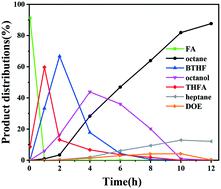当前位置:
X-MOL 学术
›
Catal. Sci. Technol.
›
论文详情
Our official English website, www.x-mol.net, welcomes your
feedback! (Note: you will need to create a separate account there.)
Highly efficient alloyed NiCu/Nb2O5 catalyst for the hydrodeoxygenation of biofuel precursors into liquid alkanes
Catalysis Science & Technology ( IF 4.4 ) Pub Date : 2020-06-19 , DOI: 10.1039/d0cy00684j Peiying Wang 1, 2, 3, 4, 5 , Yaxuan Jing 1, 2, 3, 4, 5 , Yong Guo 1, 2, 3, 4, 5 , Yan Cui 4, 6, 7, 8, 9 , Sheng Dai 4, 6, 7, 8, 9 , Xiaohui Liu 1, 2, 3, 4, 5 , Yanqin Wang 1, 2, 3, 4, 5
Catalysis Science & Technology ( IF 4.4 ) Pub Date : 2020-06-19 , DOI: 10.1039/d0cy00684j Peiying Wang 1, 2, 3, 4, 5 , Yaxuan Jing 1, 2, 3, 4, 5 , Yong Guo 1, 2, 3, 4, 5 , Yan Cui 4, 6, 7, 8, 9 , Sheng Dai 4, 6, 7, 8, 9 , Xiaohui Liu 1, 2, 3, 4, 5 , Yanqin Wang 1, 2, 3, 4, 5
Affiliation

|
Hydrodeoxygenation (HDO) is a crucial process for the synthesis of biofuels from renewable biomass. Here, several bimetallic Ni–M/Nb2O5 catalysts (M = Fe, Co, Cu) were synthesized and evaluated in the HDO of biofuel precursors (aldol adduct of furfural with acetone) to liquid alkane and it was found that Ni–Cu/Nb2O5 has the best performance (86.5% yield of octane and 5.1% yield of heptane). Various characterization techniques show that Ni–Cu alloy is formed over the Ni–Cu/Nb2O5 catalyst, which may have the main active metal sites. Moreover, the Ni–Cu alloy has more sites for the adsorption–activation of H2, leading to the high activity. During the HDO process, the ring-opening of the intermediate butyl-tetrahydrofuran (BTHF) and the conversion of octanol are two rate-determining steps. The kinetic study confirms that the ring-opening of BTHF over Ni–Cu/Nb2O5 is more favorable than that over Ni/Nb2O5. More importantly, the Ni–Cu alloy significantly restrained the undesirable decarbonylation due to the weak adsorption of carbonyl, which was key for the efficient production of Cn alkanes. This work provides an in-depth understanding of the role of Ni–Cu alloys and new insights into the design of non-noble metal catalysts for the HDO of biofuel precursors.
中文翻译:

高效合金化NiCu / Nb2O5催化剂,用于将生物燃料前体加氢脱氧成液态烷烃
加氢脱氧(HDO)是从可再生生物质合成生物燃料的关键过程。在此,合成了几种双金属Ni–M / Nb 2 O 5催化剂(M = Fe,Co,Cu),并在生物燃料前体(丙酮与糠醛的醛醇加成物)与液态烷烃的HDO中进行了评估,结果发现Ni–M / Nb 2 O 5催化剂Cu / Nb 2 O 5具有最佳性能(辛烷收率86.5%,庚烷收率5.1%)。各种表征技术表明,在Ni-Cu / Nb 2 O 5催化剂上形成了Ni-Cu合金,该催化剂可能具有主要的活性金属部位。此外,Ni-Cu合金具有更多的H 2吸附活化位点,导致活动活跃。在HDO过程中,中间体丁基四氢呋喃(BTHF)的开环和辛醇的转化是两个决定速率的步骤。动力学研究证实,BTHF在Ni–Cu / Nb 2 O 5上的开环比在Ni / Nb 2 O 5上的开环更有利。更重要的是,由于羰基的弱吸附,Ni-Cu合金显着抑制了不良的脱羰作用,这对于有效生产C n烷烃至关重要。这项工作深入了解了镍铜合金的作用,并为设计用于生物燃料前体的HDO的非贵金属催化剂设计提供了新见解。
更新日期:2020-07-06
中文翻译:

高效合金化NiCu / Nb2O5催化剂,用于将生物燃料前体加氢脱氧成液态烷烃
加氢脱氧(HDO)是从可再生生物质合成生物燃料的关键过程。在此,合成了几种双金属Ni–M / Nb 2 O 5催化剂(M = Fe,Co,Cu),并在生物燃料前体(丙酮与糠醛的醛醇加成物)与液态烷烃的HDO中进行了评估,结果发现Ni–M / Nb 2 O 5催化剂Cu / Nb 2 O 5具有最佳性能(辛烷收率86.5%,庚烷收率5.1%)。各种表征技术表明,在Ni-Cu / Nb 2 O 5催化剂上形成了Ni-Cu合金,该催化剂可能具有主要的活性金属部位。此外,Ni-Cu合金具有更多的H 2吸附活化位点,导致活动活跃。在HDO过程中,中间体丁基四氢呋喃(BTHF)的开环和辛醇的转化是两个决定速率的步骤。动力学研究证实,BTHF在Ni–Cu / Nb 2 O 5上的开环比在Ni / Nb 2 O 5上的开环更有利。更重要的是,由于羰基的弱吸附,Ni-Cu合金显着抑制了不良的脱羰作用,这对于有效生产C n烷烃至关重要。这项工作深入了解了镍铜合金的作用,并为设计用于生物燃料前体的HDO的非贵金属催化剂设计提供了新见解。











































 京公网安备 11010802027423号
京公网安备 11010802027423号